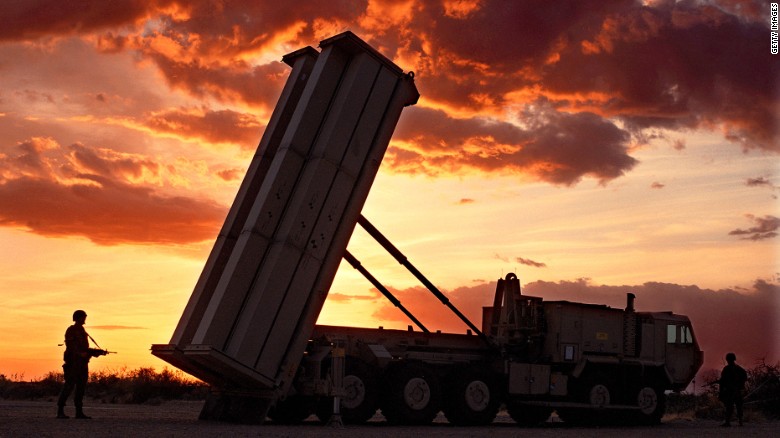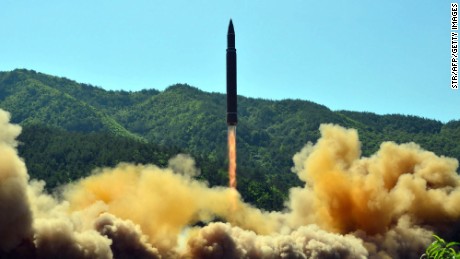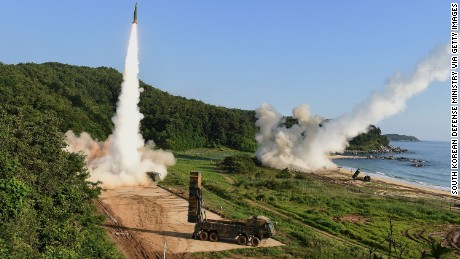There is talk of military action, which is not a real option at all.
First, the United States has some anti-ballistic missile defense (ABMD) systems operational, but they are not designed to be effective against long-range ballistic missiles.
One such ABMD is the Terminal High Altitude Area Defense (THAAD) system, which the United States recently began installing in South Korea. (In theory, THAAD's sophisticated radar might also be used against missiles originating in China, thereby threatening its nuclear deterrent, which is part of why China is so upset about THAAD.) Yes, a THAAD missile successfully intercepted a test target on Tuesday in Alaska. But the word "Area" in the acronym THAAD marks its limitation to theater or regional defense, not intercontinental defense.
Some US Navy cruisers and destroyers have the Aegis Anti-Ballistic Missile Defense system (ABMD) which is a seaborne anti-ballistic missile system, too. The Japanese Maritime Self-Defense Force has a handful of Aegis warships, too. Aegis ABMD suffers from the same limitations with respect to longer-range missiles as THAAD.
It is very hard to shoot down a ballistic missile. This is true even of a short-range ballistic missile with a relatively flat trajectory, much less a long-range missile with many more possible trajectories and a far greater speed. Field test accuracy is not a good indicator, because the shooter typically has advance notice of when and where the missile is launched.
North Korea historically staged launches or engaged in belligerent acts on important dates. For instance, they shot down a US Navy surveillance plane on April 15, 1969, then-North Korean leader Kim Il-Sung's 57th birthday, killing 30 US sailors and one marine.
More recently, North Korea launched a missile in February 2017 while US President Donald Trump and Japanese Prime Minister Shinzo Abe were meeting at Mar-a-Lago. The February missile splashdown was in the sea between Korea and Japan. And the North Koreans have been especially active with missile launches since Trump was elected.
Thus, it is likely that US military and intelligence officials expected that they might launch a missile on July Fourth -- "hey, United States, here are some fireworks for you" -- and that it would splash down in the same seas. Moreover, US and South Korean military were engaging in anti-missile exercises at the time.
Despite this, there was no attempt to shoot down the North Korean missile on July Fourth.
It is much easier to hit the missile right at launch or right before it launches. But North Korea has developed too many mobile launchers and hardened fixed launch sites for the United States to take them all out, even if they don't yet have a submarine launch capacity. This is very different from 1994, when the United States last seriously contemplated a missile strike against the North Korean nuclear program. At that time, it was conceivable that a strike hitting only a handful of sites would have done the trick.
There is controversy about how to characterize the missile the North Koreans tested -- was it truly an intercontinental ballistic missile (ICBM), capable of reaching the United States? The missile North Korea launched flew for 37 minutes, but it was fired at a very steep angle in a pop-up trajectory, which is easier than shooting for distance. And the North Koreans likely do not yet have the technology to mount a miniaturized nuclear payload on the missile and shield it sufficiently for re-entry. But they will likely be able to develop these technologies in the next five years (they are not that complicated and have been around for half a century).
They almost surely already have enough material to make several nuclear weapons. So it's fair to say that what happened on July Fourth was a watershed event and that North Korea will have the capacity to strike the continental United States in the next decade. Whether we call it an ICBM or not doesn't matter that much.
If the United States can't shoot down a North Korean missile, end their program by a military strike, or get China and Russia onboard for stiffer international sanctions, what can it do?
Contingency planning for a military strike has likely reached a level we have not seen since 1994. And the American public seems more receptive to the idea than ever before. It appears, for now, that the Trump Administration has decided to go the diplomatic route -- ramping up unilateral sanctions, including on Chinese companies suspected of dealings with North Korea. The pressure to move to a military option will likely increase if North Korea continues its torrid pace of missile tests this year, despite the heightened sanctions.
The United States and its allies would certainly win a war against North Korea. But if so, there is a strong possibility that North Korea would retaliate by launching conventional munitions at Seoul, and that hundreds of thousands of people, potentially millions (including some of the 23,500 US troops based in South Korea), would die.
In 1994, the more limited scope of any military strike made it possible that the North would not retaliate with a massive artillery counterstrike against South Korea. But for any strike to be effective today, it would have to hit many more suspected launch sites and nuclear facilities, increasing the likelihood of retaliation. Some Americans may think that's a risk we're willing to take now, rather than risk Kim Jong Un having the capability to nuke Honolulu or LA in 10 years' time.
The idea that it is better that many Koreans (and a few Americans) die now than many Americans die later may appeal to some. But the reality is that even if Kim has ICBMs that can reach the United States, there is no certainty that he will actually use them. In fact, if North Korea were to launch nuclear missiles at the United States, it would certainly result in the annihilation of Kim and his ruling regime. And Kim's abiding interest appears to be survival and the perpetuation of his rule.
We cannot risk mass innocent carnage in the present out of a fear of a dangerous and uncertain future. Just as we learned to live with a nuclear Soviet Union and China in the Cold War, we need to learn to live with a nuclear North Korea. It's fair to say that Kim with ICBMs aimed at the United States presents a greater risk than a Khrushchev, or any other Russian or Chinese leaders. But just as we survived and ultimately won that Cold War, the United States needs to muster all of its creativity, energy, and resources to manage a dangerous peace.










